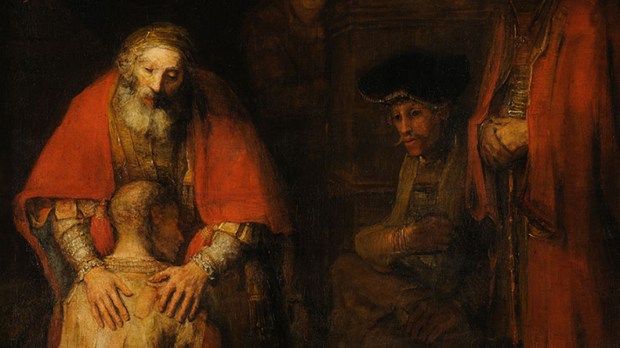The Return of the Prodigal Son (Luke 15:11-32) is one of the most memorable parables of the Bible. A young man returns home after having spent all of his father’s hard earned money in a lavish lifestyle abroad. He is broke, both financially and emotionally, and asks for his father’s forgiveness. His elderly father welcomes him home and orders a fat calf to be killed in his honor. This decision infuriates his older son, who has spent a rule-abiding life and was never rewarded with such a feast. When the older son asks his father why his unruly younger brother was worthy of such a welcoming, the father replies:
“My son, you are always with me, and everything I have is yours. But we had to celebrate and be glad, because this brother of yours was dead and is alive again; he was lost and is found.”
For thousands of years, this tale has inspired generations of believers to reflect on the virtue of forgiveness. So it is perhaps not surprising that the most talented Flemish artist of all times choose it as the subject of one of the last works. Painted in 1669, Rembrandt’s “Return of the Prodigal Son” has been considered by art historians as one of his signature paintings. Art historian Kenneth Clark declared that “those who have seen the original in St. Petersburg may be forgiven for claiming it as the greatest picture ever painted.” Rembrandt did preparatory work for at least three years, featuring drawings, etchings and light studies. He eventually opted for an oil painting with a stark light contrast between the main subjects of the picture, the father and his two sons, and the supporting figures.
Most artists tackling this subject usually depict a scene of festivity: the entire households is present and appears to be joyful. Rembrandt went for a more intimate depiction. The father does not look joyful but full of wise acceptance, while the son is suffering and finds comfort in his father’s embrace. The contrast between the father’s elaborate clothing and the son’s dire condition is highlighted in Rembrandt’s version. Next to the two main subjects are the older brother, depicted in a judgmental pose, a servant and an assistant. The mother is standing in the far left corner and appears almost as a shadow. By this unusual composition, Rembrandt wanted to highlight the moment of forgiveness, when the father lays his hands on his son to welcome him without reservations.
The emotional charge of this painting has sparked many admiring comments among art historians. According to art historian H. W. Janson “Return of the Prodigal Son” “may be [Rembrandt’s] most moving painting.” Dutch priest Henri Nouwen was so moved by the work that he dedicated an entire book to reflecting on its depths of meaning. In The Return of the Prodigal Son: A Story of Homecoming, published in 1992, Nouwen notes how Rembrandt was able to create such a poignant depiction of redemption because he had experienced both the older and younger sons’ points of view in his own life.
“When, during the last years of his life, he painted both sons in Return of the Prodigal Son, he had lived a life in which neither the lostness of the younger son nor the lostness of the elder son was alien to him. Both needed healing and forgiveness. Both needed to come home. Both needed the embrace of a forgiving father. But from the story itself, as well as from Rembrandt’s painting, it is clear that the hardest conversion to go through is the conversion of the one who stayed home,” wrote Nouwen.
Rembrandt’s “Return of The Prodigal Son” is part of the permanent collection of the State Hermitage Museum in St. Petersburg.

